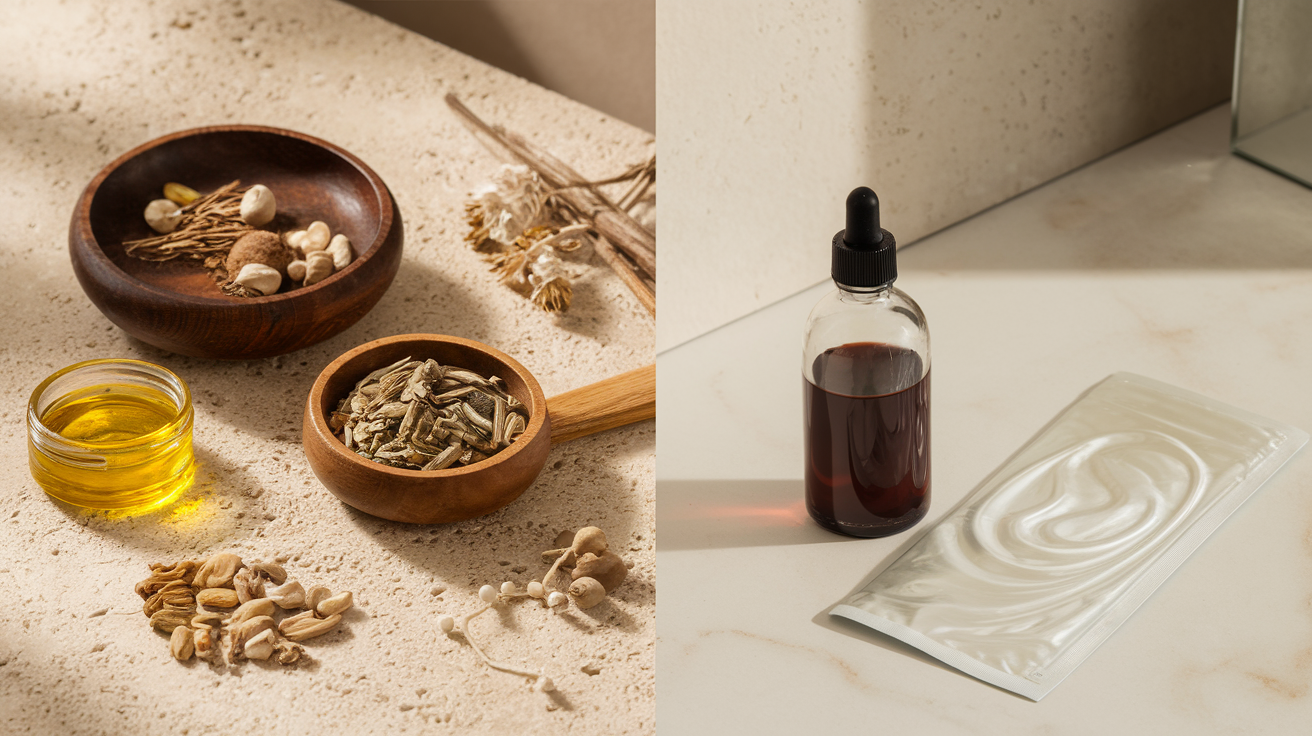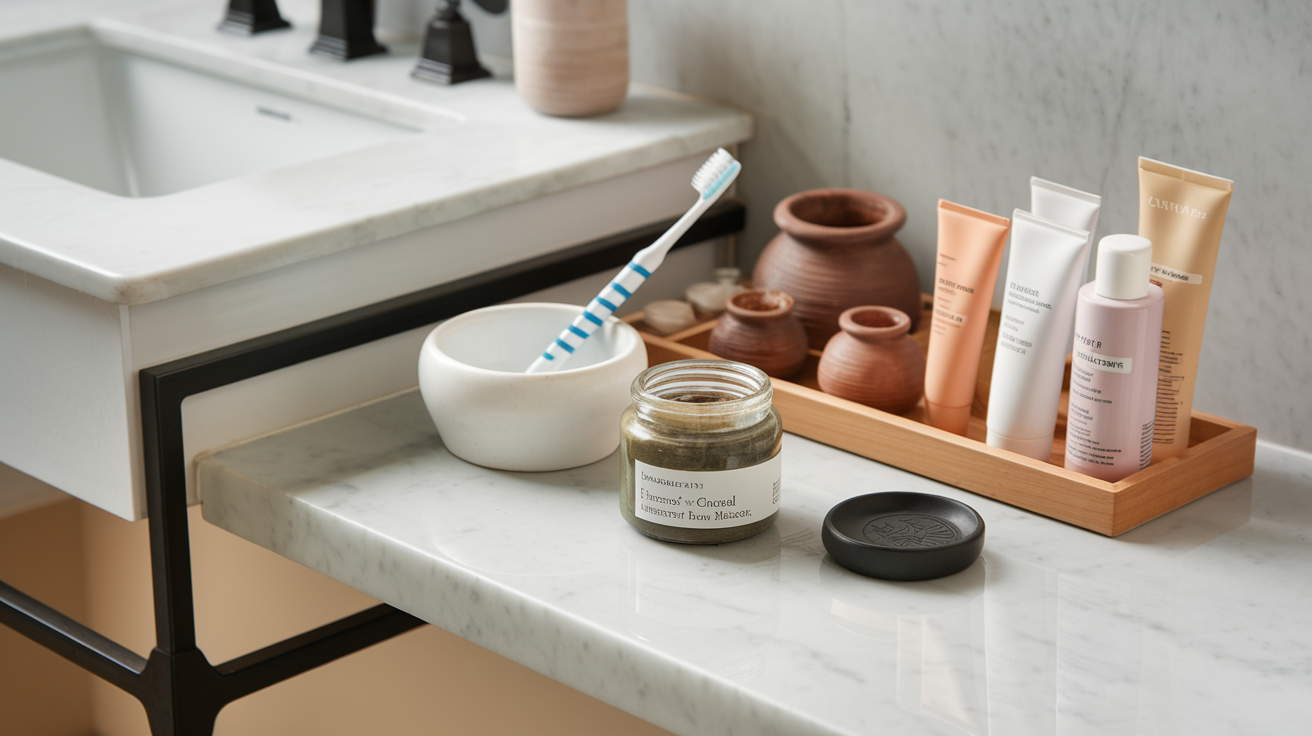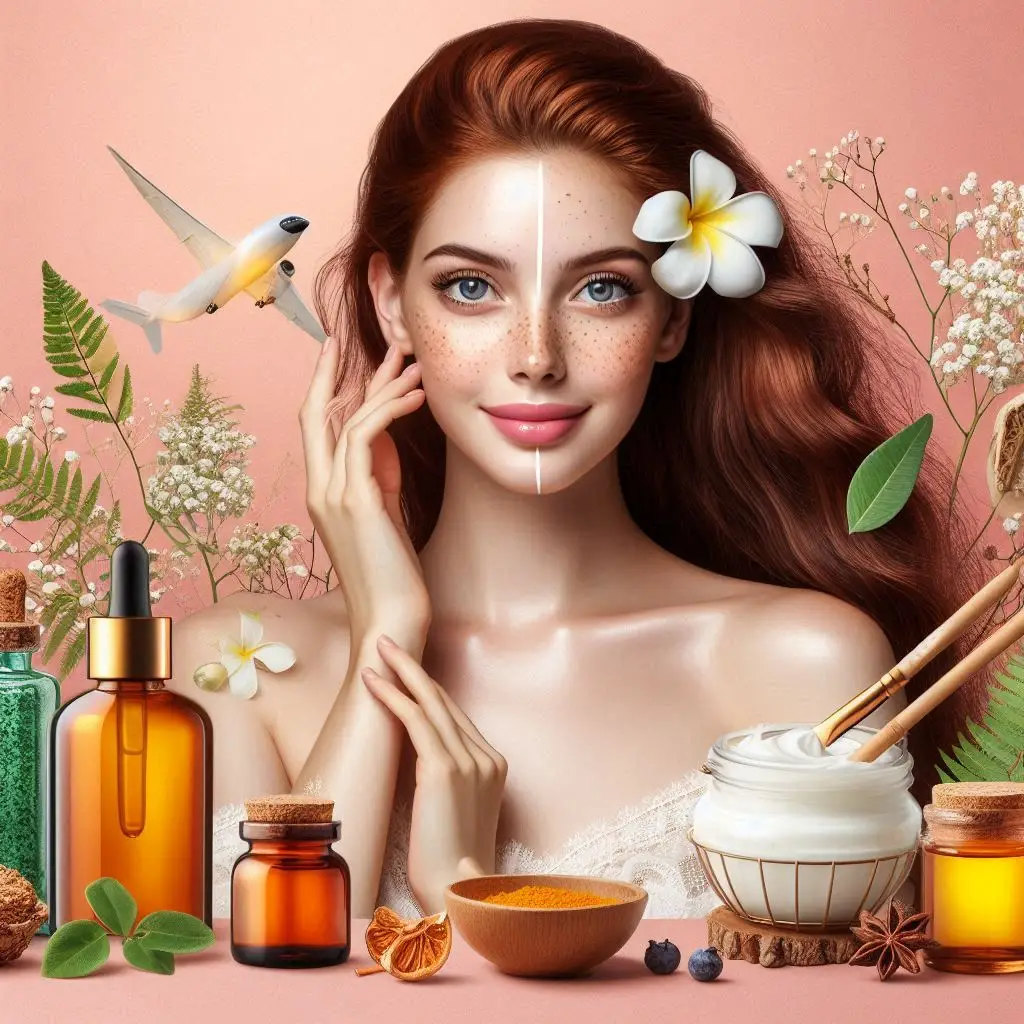“Ayurvedic vs Korean Skincare—Discover key differences, benefits & best routines for glowing, healthy skin!“
“Ayurvedic vs Korean Skincare—The Ultimate Comparison Guide!”
When comparing Ayurvedic vs Korean Skincare, understanding the unique benefits of each can help you create a personalized routine that works for your skin.

Ayurvedic vs Korean Skincare—The Ultimate Comparison Guide!
In the debate of Ayurvedic vs Korean Skincare, it’s essential to consider your skin type and specific concerns.
Many people are curious about Ayurvedic vs Korean Skincare and which might be better for their individual needs.
In a world where beauty trends evolve faster than ever, two skincare philosophies have captured global attention for their distinctive approaches and impressive results: ancient Ayurvedic wisdom and innovative Korean beauty technology. While one draws from 5,000-year-old holistic practices rooted in natural ingredients, the other leverages cutting-edge formulations and a meticulous multi-step routine. As beauty enthusiasts increasingly seek personalized skincare solutions, many find themselves wondering: which approach better addresses their unique concerns?
The answer might not be choosing one over the other, but rather understanding how to harness the best of both worlds. ✨ From sustainability considerations to effectiveness against common skin problems, this comprehensive guide will decode the philosophies, ingredients, and techniques that define these two powerhouse skincare traditions. Whether you’re battling breakouts, seeking that coveted “glass skin” glow, or simply looking to create a more mindful beauty routine, join us as we explore how Ayurvedic principles and K-beauty innovations can work together to transform your skincare regimen.
The Ancient Wisdom of Ayurvedic Skincare
The Ayurvedic vs Korean Skincare discussion often highlights the differences in ingredient sourcing and formulation philosophies.
Ultimately, the choice between Ayurvedic vs Korean Skincare depends on personal preferences and skin needs.
With Ayurveda’s focus on natural healing and Korean beauty’s innovation, the Ayurvedic vs Korean Skincare debate continues to grow.
Incorporating elements from both Ayurvedic vs Korean Skincare can lead to a balanced skincare routine.

Core Principles and Philosophy Behind Ayurvedic Beauty
Ayurvedic skincare embodies a holistic philosophy that dates back thousands of years, focusing on the balance of three fundamental doshas—Vata, Pitta, and Kapha. Unlike modern approaches that treat symptoms, Ayurveda emphasizes addressing the root causes of skin imbalances. This ancient system views beauty as multidimensional, encompassing inner, outer, and lasting beauty, with the understanding that true radiance emerges from overall wellness or “Swasthya.”
The philosophy centers on personalization rather than one-size-fits-all solutions. Each individual possesses a unique combination of doshas that influences their skin characteristics and health needs. Ayurveda recognizes that beauty isn’t merely skin deep but reflects the harmony between mind, body, and spirit, suggesting that cosmetic solutions alone cannot achieve lasting results.
Traditional Ingredients and Their Skin Benefits
Ayurvedic skincare relies on nature’s pharmacy, utilizing ingredients that have stood the test of time. These natural components serve multiple purposes in treating various skin conditions while preserving the skin’s natural pH balance.
Some key traditional ingredients include:
The synergy of Ayurvedic vs Korean Skincare can provide holistic benefits that cater to various skin concerns.
- Natural cleansers: Gentle formulations that cleanse without stripping essential oils
- Mild exfoliants: Substances that rejuvenate skin without harsh abrasion
- Nourishing oils: Rich in fatty acids and antioxidants, these oils are selected based on dosha requirements
- Ayurvedic herbs: Used for their healing properties to address specific skin concerns like acne, dryness, and signs of aging
These ingredients are often incorporated into DIY recipes and treatments tailored to individual needs, providing natural alternatives to synthetic skincare products.
Holistic Approach: Connecting Mind, Body, and Skin
The Ayurvedic approach to skincare extends beyond topical applications to encompass lifestyle practices that promote overall wellbeing. This interconnected approach recognizes that skin health is influenced by:
- Nutrient-rich diet: Emphasizing fresh fruits, vegetables, and healthy fats specific to one’s dosha
- Adequate hydration: Essential for maintaining skin elasticity and cellular function
- Quality sleep: Critical for cellular regeneration and repair
- Stress management: Techniques like meditation and yoga that reduce cortisol levels and improve skin condition
- Regular exercise: Enhances circulation and natural detoxification processes
Ayurveda particularly highlights meditation as a powerful tool for enhancing both inner and outer beauty by reducing stress and promoting overall wellness. The tradition holds that developing a balanced lifestyle is fundamental to achieving and maintaining healthy, radiant skin.
Dosha-Based Skincare Customization
At the heart of Ayurvedic skincare is customization based on individual dosha profiles:
Vata Skin Type:
- Characteristics: Typically dry, thin, and prone to fine lines
- Needs: Deep hydration and nourishment
- Recommended treatments: Rich moisturizing oils and gentle care
Pitta Skin Type:
- Characteristics: Sensitive, prone to redness and inflammation
- Needs: Cooling and calming treatments
- Recommended treatments: Sun protection and gentle, non-irritating formulations
Kapha Skin Type:
- Characteristics: Usually oily, thick, and prone to congestion
- Needs: Detoxification and stimulation
- Recommended treatments: Warm oil massages and mild exfoliation
Ayurvedic skincare routines typically involve seasonal adjustments and specific daily practices like self-massage (Snehana) to pacify doshas and promote skin health. Traditional treatments such as Abhyanga and Panchakarma offer comprehensive approaches to skin rejuvenation based on individual constitutional needs.
Now that we’ve explored the ancient wisdom of Ayurvedic skincare with its holistic, personalized approach, let’s turn our attention to the innovation-driven world of Korean skincare, which brings a different philosophy and methodology to achieving beautiful skin.
The Innovation of Korean Skincare

While ancient Ayurvedic practices focus on holistic wellness and natural ingredients, Korean skincare represents a fascinating evolution of tradition meeting cutting-edge science. Let’s explore how K-beauty has revolutionized modern skincare routines.
A. Evolution of the Famous 10-Step Routine
The Korean skincare approach has gained international acclaim with its comprehensive 10-step routine. This methodical system has evolved from traditional Korean beauty practices into a global phenomenon, with exports skyrocketing from $60 million in 2012 to an impressive $6 billion by 2021.
The routine typically follows nine essential steps:
- Oil-based cleanser
- Water-based cleanser
- Exfoliation
- Toning
- Essence application
- Targeted serums or ampoules
- Eye cream
- Moisturizer
- SPF protection
Korean beauty experts like Christine Chang and Charlotte Cho recommend adding weekly masks as an additional step for enhanced results. This systematic approach prioritizes long-term skin health rather than quick fixes.
B. Key Technologies and Breakthrough Formulations
Korean skincare stands out for its innovative formulations and cutting-edge technologies. Brands like Laneige, CosRx, and Sulwhasoo have pioneered unique product categories that didn’t previously exist in Western markets.
Notable breakthrough products include:
- Snail mucin essences (like CosRx Advanced Snail 96 Mucin Power Essence)
- Sleeping masks (such as Laneige Lip Sleeping Mask)
- Specialized toner pads (Anua Heartleaf 77% Toner Pads)
- “Glass skin” formulations (Peach & Lily Glass Skin Refining Serum)
These innovations have been introduced to international markets through key players like Peach & Lily and Soko Glam, which have served as cultural bridges bringing Korean beauty innovations to the global stage.
Understanding the fundamentals of Ayurvedic vs Korean Skincare allows consumers to make informed choices.
C. Emphasis on Hydration and Barrier Protection
Unlike some aggressive Western approaches, Korean skincare emphasizes gentle exfoliation and multiple layers of hydration. This philosophy centers on maintaining and strengthening the skin’s natural moisture barrier rather than stripping it.
Products frequently feature humectants and ingredients that support barrier function. The layering technique—applying multiple lightweight hydrating products—allows for customized moisture levels suitable for all skin types while preventing transepidermal water loss.
D. Science-Backed Ingredients Driving Results
Korean formulations blend traditional botanical knowledge with modern scientific research. Key ingredients found across popular K-beauty products include:
- Snail mucin for hydration and texture improvement
- Ginseng for anti-aging benefits (featured in premium products like Sulwhasoo’s Concentrated Ginseng Renewing Cream)
- Rice extract for brightening (found in Beauty of Joseon Relief Sun: Rice + Probiotic SPF 50)
- Heartleaf and other botanical extracts for soothing properties
These ingredients are carefully selected based on efficacy data, with brands like LYCL Inc. leveraging user data to inform their product development strategies.
E. Cultural Context of Korean Beauty Standards
The meteoric rise of K-beauty is deeply connected to Korean cultural beauty standards that prioritize luminous, hydrated skin. The ideal of “glass skin”—poreless, translucent, and radiant—has become a global aspiration.
Korean beauty brands excel at marketing strategies that connect with younger consumers. Companies like rom&nd have mastered social media engagement, while MediHeal’s collaboration with global phenomenon BTS has helped them sell over 4 billion sheet masks worldwide.
Brands like Kuoca draw inspiration from unexpected sources, including fine dining concepts, to create fresh skincare solutions that appeal to consumers seeking innovation.
Now that we’ve explored the scientific advancements and cultural context behind Korean skincare innovations, we’ll next examine how these modern approaches compare with Ayurvedic formulation philosophies to understand their fundamental differences and potential complementary benefits.
Formulation Philosophies Compared

When discussing Ayurvedic vs Korean Skincare, one must consider both traditions’ unique qualities.
The conversation around Ayurvedic vs Korean Skincare is about finding what suits your skin best.
Now that we’ve explored the innovative approach of Korean skincare with its multi-step routines and cutting-edge formulations, let’s examine how the philosophies behind Ayurvedic and Korean skincare differ in their approach to ingredients, preservation, and sensory experience.
Natural vs. Lab-Created Ingredients
Ayurvedic skincare embraces a deeply rooted philosophy in natural ingredients and plant-based formulations. This ancient Indian practice prioritizes traditional remedies derived from herbs, plants, and minerals that have been used for centuries. The growing consumer preference for these heritage-based solutions is evident as people increasingly seek products with rich histories and meaningful rituals.
Korean beauty, while also appreciating natural components, takes a more science-driven approach by combining traditional ingredients with laboratory innovations. Modern K-beauty formulations often enhance traditional actives through advancements in extraction techniques and improved bioavailability. This hybrid approach delivers clinically proven benefits that appeal to today’s informed consumers.
Key differences include:
- Ayurvedic formulations: Typically feature whole plant extracts like Centella Asiatica (known as Gotu Kola in Ayurveda), licorice derivatives, and moringa in their most natural forms
- Korean products: Often contain highly refined or bio-engineered versions of natural ingredients alongside synthetic compounds designed for specific functions
For example, while an Ayurvedic product might use traditional Gotu Kola extract, Korean formulations might incorporate Biogenic Asiaticoside-200, a concentrated compound derived from Centella Asiatica specifically isolated for enhanced skin repair properties.
Preservation Methods and Shelf Life
The divergence in preservation philosophy significantly impacts product longevity and formulation:
Ayurvedic skincare traditionally relies on natural preservatives such as neem, turmeric, and essential oils. This approach aligns with Ayurveda’s holistic wellness perspective but often results in shorter shelf life. Many authentic Ayurvedic products require refrigeration or must be used within weeks of opening.
Korean skincare, with its focus on stability and consistency, typically incorporates modern preservation systems that extend shelf life considerably. These might include carefully selected parabens, phenoxyethanol, or newer alternative preservatives that maintain product integrity for 12-36 months after opening.
This fundamental difference affects everything from packaging to usage instructions:
| Aspect | Ayurvedic Approach | Korean Approach |
|---|---|---|
| Shelf Life | Generally shorter (3-6 months) | Extended (1-3 years) |
| Packaging | Often in glass or sustainable materials | Airless pumps, specialized containers to prevent contamination |
| Storage Needs | May require refrigeration or cool storage | Stable at room temperature |
Texture and Sensory Experience Differences
The sensory aspects of skincare products create distinctly different user experiences between these traditions:
Ayurvedic formulations typically feature richer textures with natural oils and butters. These products often have pronounced herbal aromas reflecting their botanical origins. The application experience tends to be more ritualistic, with massage techniques being integral to product efficacy. Inveda’s products, which blend Ayurvedic principles with modern formulation, maintain these sensorial qualities while optimizing absorption.
Korean skincare prioritizes lightweight, fast-absorbing textures that layer well in multi-step routines. These products frequently feature sophisticated textures that transform during application—from gels to waters, or powders to creams. Fragrances tend to be subtle or absent, catering to sensitive skin concerns. The Korean approach emphasizes immediate sensory feedback like cooling effects, temporary tightening, or visible dewiness.
These texture differences extend to application methods:
Both Ayurvedic vs Korean Skincare traditions emphasize wellness, making them appealing to holistic beauty seekers.
- Ayurvedic routines typically incorporate specific massage techniques that stimulate circulation and energy points
- Korean routines focus on patting motions and precise layering of multiple lightweight products
With these formulation philosophies in mind, next we’ll explore how these different approaches translate to effectiveness for common skin concerns, examining which tradition might offer better solutions for specific skin issues.
Effectiveness for Common Skin Concerns

Now that we’ve examined the philosophical differences in formulation between Ayurvedic and Korean skincare approaches, let’s analyze how each performs when addressing specific skin concerns that many of us face daily.
A. Acne and Blemish Control Approaches
Ayurvedic skincare offers time-tested solutions for acne with powerful natural ingredients. Neem, renowned for its antibacterial properties, effectively combats acne-causing bacteria without harsh chemicals. Turmeric, another Ayurvedic staple, reduces inflammation and redness associated with breakouts while promoting healing.
Korean skincare approaches acne differently, focusing on gentle exfoliation and hydration balance rather than drying out the skin. Their formulations often include:
- Salicylic acid in lower concentrations
- Tea tree extracts for antimicrobial action
- Centella asiatica (cica) to calm irritation
While Ayurvedic remedies are particularly suitable for Indian climates and can be budget-friendly or even homemade, Korean products offer precision-targeted treatments that may work faster but at a higher price point.
B. Anti-Aging Strategies Compared
As trends evolve, the Ayurvedic vs Korean Skincare dialogue remains relevant for skincare enthusiasts.
Korean Beauty has gained worldwide recognition for its innovative anti-aging approach. Rather than waiting for wrinkles to appear, K-beauty emphasizes prevention through intense hydration and sun protection. Their multi-step routines incorporate:
- Multiple layers of hydration
- Specialized serums with peptides
- Essences rich in fermented ingredients
- Consistent sun protection as a non-negotiable step
Ayurvedic anti-aging strategies take a more holistic view, addressing internal balance and external care. Ingredients like sandalwood and coconut oil naturally preserve skin elasticity while promoting overall wellness. The Ayurvedic approach connects aging with digestive health and stress management, offering a comprehensive solution beyond topical applications.
C. Hyperpigmentation Solutions
For hyperpigmentation concerns, both systems offer effective but methodologically different approaches:
| Ayurvedic Solutions | Korean Solutions |
|---|---|
| Turmeric masks to even skin tone | Brightening serums with vitamin C |
| Sandalwood to lighten dark spots | Targeted treatments with niacinamide |
| Holistic diet recommendations to address internal causes | Gentle chemical exfoliants to remove discolored cells |
Ayurvedic remedies may take longer to show results but address the root causes of hyperpigmentation, while Korean treatments often deliver more immediate visible improvements through their innovative ingredients.
D. Sensitive Skin Treatments
Sensitive skin particularly benefits from Ayurvedic skincare’s gentle, natural approach. The reference content specifically notes that Ayurvedic formulations are well-suited for sensitive skin types due to their minimal processing and natural ingredient profiles. Cooling ingredients like aloe vera and rose water soothe irritation without triggering reactions.
Korean skincare has responded to sensitive skin needs with fragrance-free formulations and lines dedicated to skin barrier repair. However, the multi-step routine and some innovative ingredients might overwhelm truly sensitive skin. The text mentions that some Korean Beauty formulations may not be suitable for sensitive skin types, making Ayurveda potentially more appropriate in these cases.
For those with sensitivity, a hybrid approach might work best—using Ayurvedic cleansers and treatments while incorporating select Korean hydration products specifically formulated for sensitive skin.
With an understanding of how each skincare philosophy addresses common skin concerns, we’ll next explore the sustainability and ethical considerations of both Ayurvedic and Korean beauty approaches—an increasingly important factor in conscious consumers’ skincare decisions.
Sustainability and Ethical Considerations

Now that we’ve examined how both Ayurvedic and Korean skincare approaches address various skin concerns, it’s equally important to understand their environmental and ethical implications. Sustainability has become a crucial consideration for conscious consumers when choosing skincare products.
Environmental Impact of Ingredients
Korean skincare brands have been increasingly embracing sustainable practices while maintaining their innovative edge. Brands like Innisfree draw inspiration from natural environments such as Jeju Island, focusing on ethical sourcing of ingredients. Their popular Green Tea Hyaluronic Acid Serum exemplifies their commitment to preserving the integrity of natural ingredients through specialized extraction techniques.
Whamisa stands out as a pioneer in sustainable Korean skincare with its organic-certified facility. Their innovative fermentation processes enhance product efficacy, as demonstrated in their Organic Flowers Deep Rich Essence Toner. The brand utilizes traditional methods of natural preservation, ensuring product freshness through plant nanoparticles rather than harmful synthetic preservatives.
PURITO has made sustainability central to their formulation philosophy, creating products like the Centella Unscented Serum that strengthens and hydrates skin while minimizing environmental impact. Similarly, COSRX prioritizes minimalistic formulations that avoid harmful additives, making their Low pH Good Morning Gel Cleanser both effective for oily or acne-prone skin and environmentally responsible.
Packaging Approaches and Waste
The contrast between Ayurvedic and Korean approaches to packaging reveals different priorities in waste reduction. Within the K-beauty realm, brands like RE:P have embraced eco-friendly practices, utilizing recyclable packaging for products such as their All-Night Moisture & Relief Mask. Their minimalist formulations also help reduce overall waste in the production process.
PURITO demonstrates commitment to reducing plastic waste by incorporating post-consumer recycled materials in their packaging. This approach addresses one of the most significant criticisms of the Korean beauty industry—excessive packaging that contributes to environmental waste.
While traditional Ayurvedic products often come in simpler packaging, Korean brands are innovating to close this sustainability gap through thoughtful design choices and materials selection.
Animal Testing Policies
The ethics of animal testing represents a critical consideration when comparing these skincare traditions. Within Korean skincare, there’s a complex landscape regarding cruelty-free practices. Many popular Korean brands, including Laneige, Erborian, and Innisfree, still engage in animal testing, particularly due to distribution requirements in mainland China where animal testing is mandated by law.
However, there’s a growing movement of cruelty-free Korean skincare brands. Aprilskin, Klairs, and Glow Recipe stand out for their commitment to cruelty-free principles. COSRX, Benton, and Purito have also established themselves as ethical options that avoid animal testing while maintaining efficacy.
For truly vegan options that contain no animal-derived ingredients or by-products, consumers need to research carefully, as not all cruelty-free products are necessarily vegan. Some Korean brands offer specific vegan product lines rather than being 100% vegan across their entire range.
RE:P promotes a strong cruelty-free stance alongside their environmentally conscious packaging, demonstrating that ethical considerations can align with effective formulations containing soothing ingredients like Centella Asiatica.
With these sustainability and ethical factors in mind, we’ll next explore how to create an ideal hybrid routine that combines the best aspects of both Ayurvedic and Korean skincare approaches. By carefully selecting products that align with both your skin’s needs and your ethical values, you can develop a personalized regimen that honors traditional wisdom while embracing modern innovation.
Creating Your Ideal Hybrid Routine

Now that we’ve explored the sustainability and ethical considerations of both skincare traditions, let’s focus on how to effectively combine them for optimal results. The beauty of Ayurvedic and Korean skincare approaches lies in their complementary nature, allowing you to create a personalized routine that harnesses the best of both worlds.
Compatible Products from Both Traditions
The integration of Ayurvedic principles with Korean skincare routines offers unique benefits that neither approach can deliver alone. The ancient wisdom of Ayurveda, with its focus on natural ingredients and holistic well-being, pairs wonderfully with Korean beauty’s innovative formulations and layering technique.
For an effective hybrid routine, consider these compatible combinations:
- Cleansing: Begin with Korean double cleansing using an oil-based cleanser followed by Inveda’s Cica Healing Facewash, which incorporates Ayurvedic healing herbs
- Toning: Apply Inveda’s Damascena Rose Toner, which blends Korean-inspired pore-minimizing technology with Ayurvedic rose extracts
- Treatment: Layer K-beauty serums targeted for specific concerns
- Moisturizing: Finish with Inveda’s Cica Healing Day Cream that offers the hydration focus of K-beauty with the healing properties of Ayurvedic ingredients
Morning vs. Evening Routine Suggestions
Morning Routine (Ayurvedic-Korean Hybrid):
- Gentle cleanse with a water-based cleanser
- Apply Damascena Rose Toner to balance pH and minimize pores
- Layer hydrating Korean essences or serums
- Moisturize with Inveda’s Cica Healing Day Cream for lasting hydration
- Finish with Inveda’s Sunscreen Cream Gel SPF 50 for essential UV protection
Evening Routine (Ayurvedic-Korean Hybrid):
- Double cleanse – first with an oil-based cleanser to remove makeup and sunscreen, then with Inveda’s Cica Healing Facewash
- Apply Damascena Rose Toner
- Incorporate more intensive Korean treatments or masks
- Complete with a richer Ayurvedic moisturizer or overnight treatment
Identifying Which Approach Suits Your Skin Type
Different skin types benefit from varying combinations of these traditions:
For Oily Skin:
Despite what might seem counterintuitive, oil-based Ayurvedic products can actually balance sebum production. Combine these with Korean products featuring lightweight hydration and gentle exfoliation for optimal results. Inveda’s oil-based cleansers work effectively to regulate excess oil while maintaining your skin’s natural barrier.
For Dry Skin:
Patience in product selection is crucial. Layer hydrating Korean essences and serums beneath richer Ayurvedic moisturizers. This combination provides both immediate hydration and longer-lasting moisture retention, addressing dry skin concerns from multiple angles.
For Combination or Sensitive Skin:
The gentle approach of both traditions makes them ideal for reactive skin. Focus on Cica-containing products from both traditions, as this ingredient features prominently in both Ayurvedic (as Centella Asiatica) and Korean formulations.
Ultimately, understanding Ayurvedic vs Korean Skincare can empower consumers to choose wisely for their skin health.
Seasonal Adjustments for Optimal Results
Through exploring Ayurvedic vs Korean Skincare, one gains insights into effective skincare solutions.
The hybrid approach offers excellent flexibility for adapting to seasonal changes:
Summer Adjustments:
- Increase emphasis on Korean lightweight hydration
- Use Inveda’s Sunscreen Cream Gel SPF 50 more frequently
- Incorporate more cooling Ayurvedic ingredients
Winter Adjustments:
- Increase oil-based Ayurvedic products for barrier protection
- Reduce exfoliation frequency
- Layer multiple hydration products following the Korean approach
Combining these two powerful skincare traditions thoughtfully not only creates a routine, but also embraces a lifestyle change that can enhance your natural beauty and confidence. By combining ancient Ayurvedic wisdom with innovative Korean approaches, you can achieve the coveted “glass skin” while honoring holistic wellness principles.

Both Ayurvedic and Korean skincare offer unique approaches to achieving healthy, radiant skin. While Ayurveda draws on centuries of holistic wisdom using natural ingredients tailored to individual doshas, Korean skincare leverages innovation and technology through its detailed multi-step routines. Each system has its strengths—Ayurveda excels for those seeking gentle, natural solutions for sensitive skin, while Korean methods deliver quick results for those willing to invest time in their regimen.
The beauty of modern skincare lies in the freedom to create your own hybrid routine that honors both traditions. Whether you prioritize sustainability, effectiveness for specific concerns, or simply enjoy the ritual of self-care, elements from both philosophies can be incorporated into a personalized approach. Remember that the best skincare routine is one that respects your skin’s unique needs while aligning with your personal values and lifestyle. Your perfect skincare journey might just be found at the intersection of ancient wisdom and contemporary innovation.
Many find that blending Ayurvedic vs Korean Skincare practices yields the best results for their skin.
By combining Ayurvedic vs Korean Skincare, you can tap into the strengths of both philosophies.
The hybrid approach of Ayurvedic vs Korean Skincare can help you achieve your desired skin goals.
Those exploring Ayurvedic vs Korean Skincare often appreciate the variety it brings to their routines.
In conclusion, Ayurvedic vs Korean Skincare offers diverse methods for glowing skin.
Understanding Ayurvedic vs Korean Skincare provides valuable insight for skincare enthusiasts.
The journey of Ayurvedic vs Korean Skincare is about finding balance and harmony for your skin.
Ultimately, the choice of Ayurvedic vs Korean Skincare should resonate with your skin’s unique needs.
As you navigate Ayurvedic vs Korean Skincare, consider how each can contribute to your beauty ritual.



